Toads are fascinating amphibians that play an important role in the ecosystems they inhabit.
In Arizona State, toads can be found in various habitats, from the Sonoran Desert to the high-elevation forests of the Mogollon Rim.
While they may seem similar at first glance, each species has unique physical characteristics, behaviors, and adaptations that allow it to thrive in its specific environment.
In this article, we will explore nine toad species found in Arizona. We delve into their habitat, distribution, behaviors, adaptations, and whether they’re poisonous to humans.
1: Colorado River Toad (Incilius alverius)
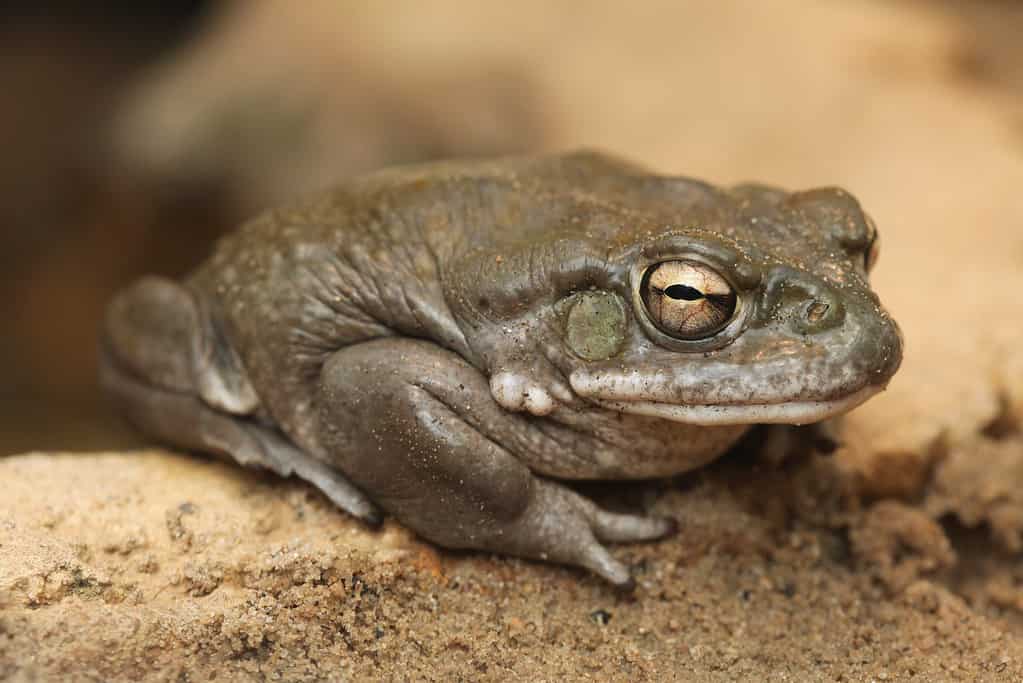
Colorado River toads are primarily nocturnal and semi-aquatic.
©Vladimir Wrangel/Shutterstock.com
Also known as the Sonoran Desert toad, the Colorado River Toad is a large toad species found in the arid regions of the southwestern U.S. and northwestern Mexico. Here are some important facts about this fascinating amphibian:
Habitat and Distribution
The toad is primarily found in the Sonoran and Mojave Deserts and in riparian areas along rivers and streams in Arizona, California, Nevada, New Mexico, and northwestern Mexico.
They prefer to live in areas with sandy or rocky soils and low vegetation cover.
Behaviors and Adaptations
Colorado River toads are primarily nocturnal and semi-aquatic, spending most of their days in burrows or hiding under rocks to avoid the harsh desert sun.
They have a distinctive, loud call to attract mates and warn predators.
One of their most notable adaptations is the venom glands on their skin, which produce a potent toxin that can be deadly to predators and humans.
This venom contains several psychoactive compounds, including 5-MeO-DMT, which has led to the Colorado River toad being used recreationally as a hallucinogen.
Additionally, they can store water in their bladder. This enables them to survive in arid environments with limited water sources.
Are They Poisonous to Humans?
While Colorado River toads aren’t aggressive toward humans, they can be dangerous if handled improperly.
Their venom glands are located on their skin, and contact with the venom can cause a range of symptoms, including:
- Nausea
- Vomiting
- Convulsions
- Death in rare cases
Handle Colorado River Toads with care and wash your hands thoroughly after coming into contact with them. If you or someone else experiences symptoms after handling one, seek medical attention immediately.
2: Great Plains Toad (Anaxyrus cognatus)
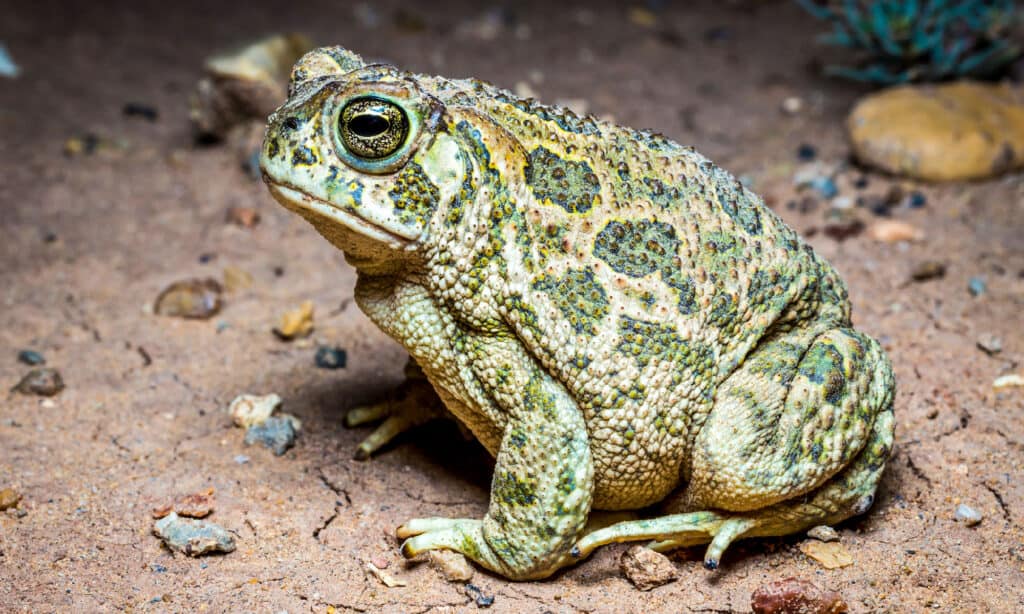
They secrete a mild toxin from their skin that can cause skin irritation and other symptoms.
©iStock.com/Timothy Cota
This is a small toad species widely distributed across the Great Plains of North America, including Arizona. Adults typically reach 2-4 inch lengths and have a distinctive appearance with gray or olive-green skin and dark spots.
Habitat and Distribution
Great Plains toads can be found in various habitats, including:
- Grasslands
- Prairies
- Shrublands
In Arizona, they’re primarily found in the central and eastern portions of the state. They breed in shallow pools and wetlands during the spring and early summer.
Behaviors and Adaptations
Great Plains Toads have several adaptations to survive in their arid habitats.
They can burrow underground during hot and dry periods, and their skin can retain moisture to help prevent dehydration.
Are They Poisonous to Humans?
Great Plains Toads are not typically aggressive and are not considered dangerous to humans.
But they secrete a mild toxin from their skin that can cause skin irritation and other symptoms if it comes into contact with skin or mucus membranes.
3: Red-spotted Toad (Anaxyrus punctatus)

Red-spotted Toads are not considered dangerous to humans and are not typically aggressive.
©iStock.com/Timothy Cota
This is a small toad species with a distinctive appearance, characterized by red or orange spots on its back and legs. Adults typically reach 2-3 inch lengths and have a pale green or beige coloration.
Habitat and Distribution
Red-spotted Toads are found in various habitats, including:
- Rocky canyons
- Arid grasslands
- Desert scrublands
They’re distributed across the western U.S. and can be found throughout Arizona. They breed in shallow pools and streams during the summer monsoon season.
Behaviors and Adaptations
During the breeding season, males will call out to females with a high-pitched trill. After mating, females will lay their eggs in shallow pools or streams, and the tadpoles will develop into juvenile toads in just a few months.
One of the unique adaptations of the Red-spotted Toad is its ability to secrete a sticky, white substance from its skin when threatened. This substance can deter predators and allow the toad to escape.
Are They Poisonous to Humans?
Red-spotted Toads are not considered dangerous to humans and are not typically aggressive.
But they secrete a mild toxin from their skin that can cause skin irritation and other symptoms if it comes into contact with skin or mucus membranes.
4: Arizona Toad (Anaxyrus microscaphus)
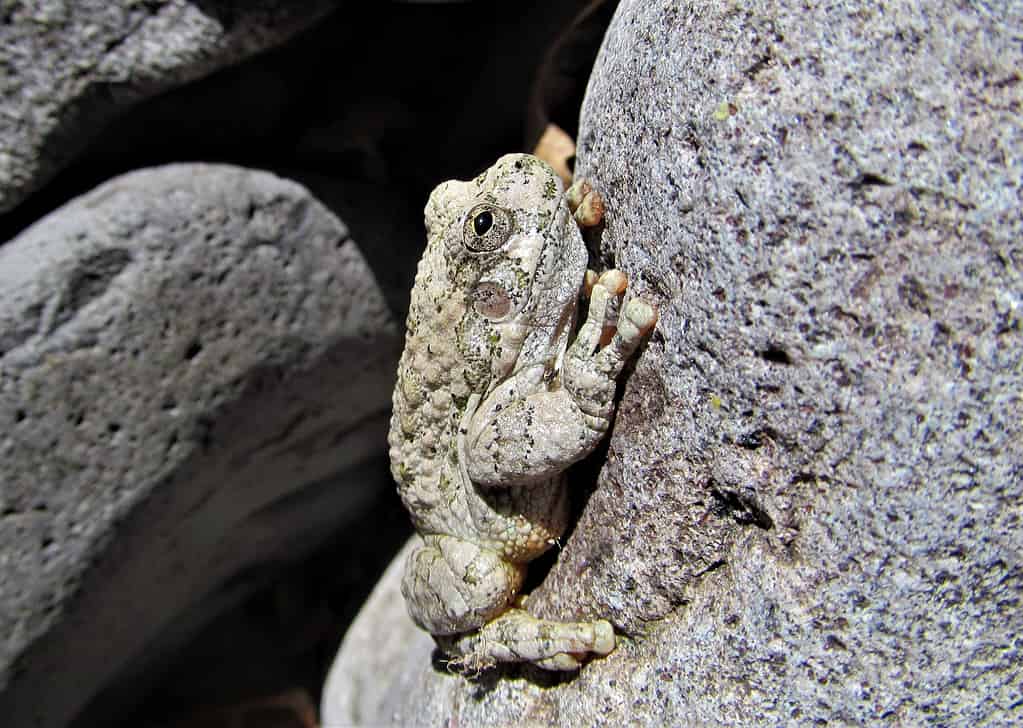
Arizona toads can burrow underground during hot and dry periods, and their skin can retain moisture to help prevent dehydration.
©RJ Ridley/Shutterstock.com
This is a medium-sized toad species endemic to Arizona, meaning it’s found nowhere else in the world.
Adults typically reach 2-3.5 inch lengths and have a distinctive appearance with light brown or greenish-gray skin and dark spots.
Habitat and Distribution
Arizona Toads are primarily found in the central and southern portions of Arizona, inhabiting various habitats, including:
- Riparian areas
- Grasslands
- Desert scrublands
They breed in shallow pools and streams during the summer monsoon season.
Behaviors and Adaptations
Arizona Toads have several adaptations that allow them to survive in their arid habitats.
They can burrow underground during hot and dry periods, and their skin can retain moisture to help prevent dehydration.
Are They Poisonous to Humans?
Arizona Toads are not typically aggressive and are not considered dangerous to humans. But they secrete a mild toxin from their skin that can cause skin irritation and other symptoms if it comes into contact with skin or mucus membranes.
5: Woodhouse’s Toad (Anaxyrus woodhousii)
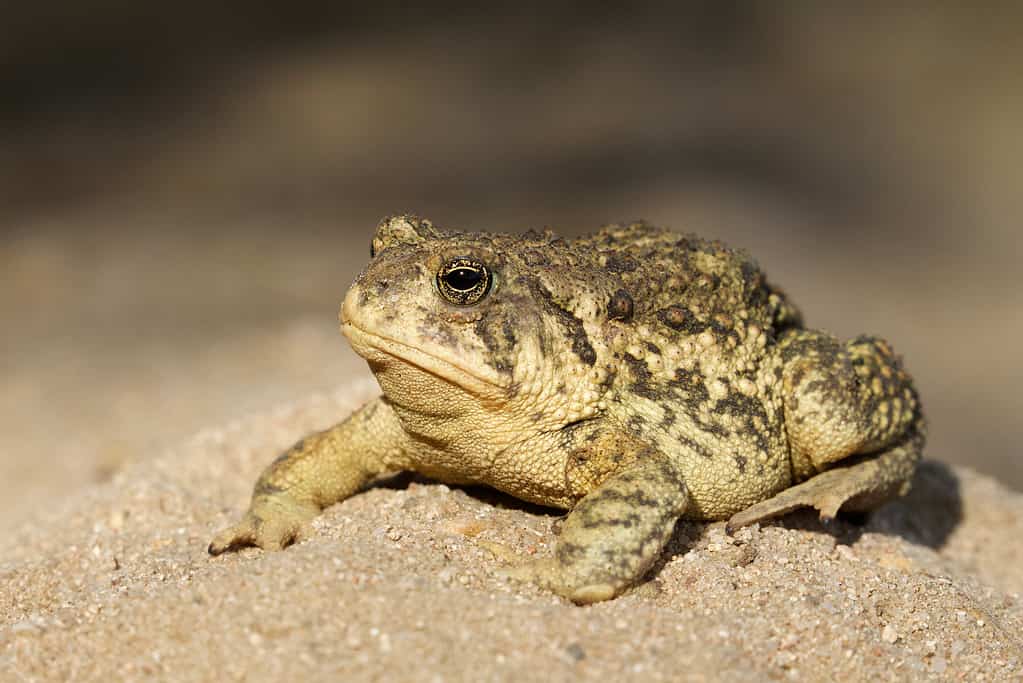
Woodhouse toads breed in shallow pools and streams during the summer monsoon season.
©Tom Reichner/Shutterstock.com
This medium-sized toad species is throughout much of the western U.S., including Arizona.
Adults typically reach 2-4 inches long and have a gray or brown coloration with dark spots.
Habitat and Distribution
Woodhouse’s Toads are in various habitats, including:
- Riparian areas
- Grasslands
- Desert scrublands
They’re distributed across the western U.S. and can be found throughout Arizona. They breed in shallow pools and streams during the summer monsoon season.
Behaviors and Adaptations
Woodhouse’s Toads have several adaptations that allow them to survive in their arid habitats. For example, they can burrow underground during hot and dry periods, and their skin can retain moisture to help prevent dehydration.
Are They Poisonous to Humans?
Woodhouse’s Toads are not typically aggressive and are not dangerous to humans.
But they secrete a mild toxin from their skin that can cause skin irritation and other symptoms if it comes into contact with skin or mucus membranes.
6: Couch’s Spadefoot Toad (Scaphiopus couchii)

Couch’s spadefoot toads have a distinctive spade-like structure on their hind legs for digging burrows to escape the hot and dry conditions
©Viktor Loki/Shutterstock.com
This small toad species is in the southwestern U.S., including Arizona. Adults typically reach 2-3 inch lengths and have a light gray or green coloration with distinctive yellow or green eyes.
Habitat and Distribution
Couch’s Spadefoot Toads are found in various arid habitats, including:
- Desert scrublands
- Grasslands
They’re distributed across the southwestern U.S., including Arizona, where they can be found in both low- and high-elevation areas.
They breed in shallow pools during the summer monsoon season.
Behaviors and Adaptations
Couch’s Spadefoot Toads have several unique adaptations that allow them to survive in their arid habitats.
They have a distinctive spade-like structure on their hind legs for digging burrows to escape the hot and dry conditions.
They can aestivate (enter a dormant state) for months to conserve water and energy during periods of extreme drought.
Are They Poisonous to Humans?
Couch’s Spadefoot Toads are not typically aggressive and are not dangerous to humans.
But their skin secretions can cause skin irritation and other symptoms if they come into contact with skin or mucus membranes.
7: Green Toad (Anaxyrus debilis)
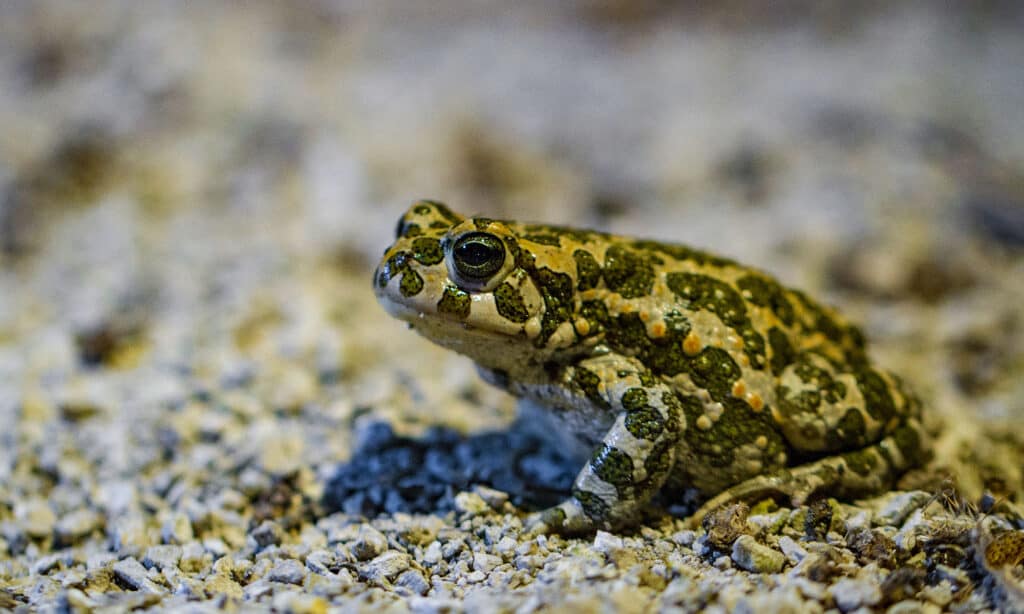
The green toad is secretive and hard to spot.
©Lillian Tveit/Shutterstock.com
Also known as the Texas Green Toad, the Green Toad is a small toad species in parts of Arizona, as well as Texas, New Mexico, and Mexico.
Adults can reach lengths of up to 2.5 inches and have a distinctive bright green coloration with dark spots on their backs.
Habitat and Distribution
The Green Toad is in various habitats, including:
- Desert grasslands
- Rocky slopes
- Open woodlands
In Arizona, they’re primarily in the state’s southeastern part. They’re typically active at night and can burrow underground to escape the heat during the day.
Behaviors and Adaptations
Green Toads are primarily nocturnal and feed on:
- Insects
- Spiders
- Other small invertebrates
The Green Toad has several adaptations that allow it to survive in its environment. For example, they can burrow underground to escape the heat and dryness, and their skin can retain moisture to help prevent dehydration.
They can also produce a mild toxin from their skin that deters predators.
Are They Poisonous to Humans?
While the toxin produced by the Green Toad is not harmful to humans, their skin secretions can cause skin irritation and other symptoms if they come into contact with skin or mucus membranes.
8: Sonoran Green Toad (Anaxyrus retiformis)
This is a small, brightly colored toad species found in the southwestern U.S. and northern Mexico. Here are some details about this unique species:
Habitat and Distribution
The Sonoran Green Toad is primarily in the Sonoran Desert and adjacent regions of Arizona, California, and Mexico.
They prefer to live in rocky areas, such as:
- Canyons
- Foothills
- Mountains
They’re often near streams or other sources of water.
Behaviors and Adaptations
Sonoran Green Toads are active at night and spend much of the day hiding in rocky crevices to avoid predators and the hot desert sun. They can tolerate a wide range of temperatures and can survive in areas with very little water.
These toads have a unique defense mechanism. When threatened, they will puff up their bodies and secrete a milky toxin from their skin, which can harm predators and even humans if ingested.
Are They Poisonous to Humans?
The toxin produced by the Sonoran Green Toad can harm humans if ingested or if the toad’s secretions come into contact with open wounds or mucous membranes.
Avoid handling these toads, and wash your hands thoroughly if you come into contact with them.
9: Mexican Spadefoot Toad (Spea multiplicata)
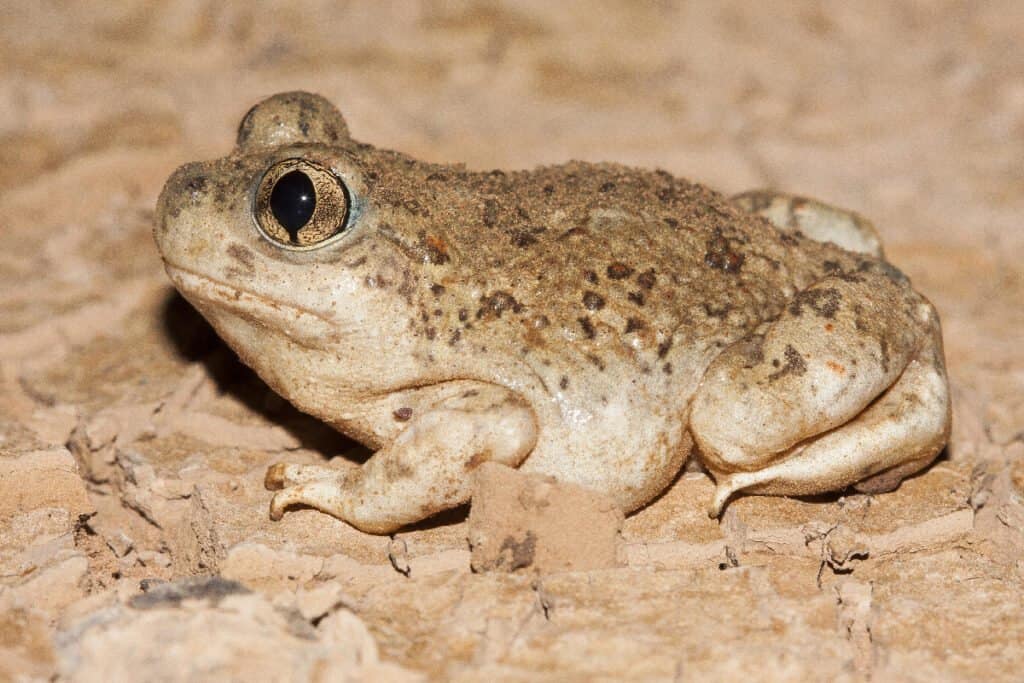
Desert spadefoot toads blend in well with the sand in their native habitats, but if you can find one, they are a delight to observe
©Viktor Loki/Shutterstock.com
This is a unique toad species that are primarily in Mexico but also in parts of the southwestern U.S. Here are some details about this interesting species:
Habitat and Distribution
Mexican Spadefoot Toads are in various habitats, including:
- Desert
- Grassland
- Woodlands
They’re most commonly in Mexico but are also in parts of:
- Arizona
- New Mexico
- Texas
- California
Behaviors and Adaptations
Mexican Spadefoot Toads are nocturnal and spend much of their time underground in burrows to avoid the hot desert sun.
They have adapted to living in arid environments by being able to store water in their bodies and excrete concentrated urine to conserve water.
These toads have a unique adaptation. They have a hard, keratinized spade on their hind feet that they use to burrow into the ground.
Are They Poisonous to Humans?
Mexican Spadefoot Toads are not typically dangerous to humans.
But like many toad species, they secrete toxins from their skin that can be harmful if ingested or if the secretions come into contact with open wounds or mucous membranes.
Key Takeaways
Arizona is home to diverse toad species, each with unique characteristics, adaptations, and importance in the ecosystem. Each species plays a crucial role in maintaining the delicate balance of nature from the Sonoran Desert Toad with its powerful toxin to the Green Toad with its bright green coloration.
The photo featured at the top of this post is © Viktor Loki/Shutterstock.com
Thank you for reading! Have some feedback for us? Contact the AZ Animals editorial team.






